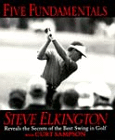Five Fundamentals: Steve Elkington reveals the secrets of the best swing in golf
In December 1998 Steve Elkington and the rest of the International Team whacked the U.S. Team in the President’s Cup. The lopsided score made me think that maybe Elkington gave his teammates an advance copy of his new book.
Actually, the President’s Cup results reminded me of former Baltimore Orioles Manager Earl Weaver’s explanation why his teams won so many games: “Good pitching and 3-run homers.”
In other words, chance obviously plays a role in athletic competition, but great fundamentals will always give you an edge.
That’s the point of this book. Elkington and co-author Curt Sampson (see The Masters) set out to do more than the usual do-it-my-way instructional book by a PGA Tour pro. They succeeded quite nicely.
The difference is immediately apparent. The top and bottom outside corners are filled with 2-inch square photographs depicting Elkington’s swing for his driver, six-iron, and sand wedge. This classic “flip book” technique shows any reader at a glance why so many pros are jealous of Elkington’s swing mechanics.
As he is careful to remind you, however, his swing is not a matter of where he stepped out of the gene pool, but a carefully honed technique that can be learned by others, with practice.
We also learn a bit of Steve’s biography. I especially liked the parts dealing with his college days at Houston, where he met Clyde (The Glide) Drexler and Hakeem (The Dream) Olajuwan. The passages describing the last round of the 1995 PGA, his major win at Riviera, were also very interesting, especially if you recall the description of Brad Faxon’s round the same day in Bob Rotella’s Golf Is A Game of Confidence.
The first four basics of the grip, the setup, the backswing, and the downswing are covered well. I found myself grabbing my 4-wood from my garage to compare my usual grip to the one Elkington recommends. The many photographs are helpful in this segment and the others.
For Elkington, the fifth fundamental is a sense of rhythm and tempo. This takes his list of swing basics a step further than Ben Hogan’s Five Lessons. He explains well the basis for this requirement, without making it an insurmountable goal for less athletic golfers.
The last two chapters stress two other fundamentals: the short game and general physical conditioning for golfers. Both make liberal use of photographs to illustrate the various techniques and exercises. (Earlier in the book, Elkington couldn’t resist teasing his “bookish” co-author about Sampson’s troubles with a medicine ball exercise. Based on the description it would have made a funny video clip.)
The need to practice is stressed throughout the book, and could be described as yet another fundamental of good golf. That’s not a revelation, but the understated way in which it is stressed helps to reinforce the point.
There’s a nice tone to this book. It reads like the two authors had fun doing it together. Elkington has always given the impression he is a genuinely nice guy who happens to be very good at what he does for a living. This book helps show you why his game is so good, while also giving some insight into his winning personality. It’s well worth reading.
Review date: December 14, 1998
Also published in The Cape Gazette on January 22, 1999


